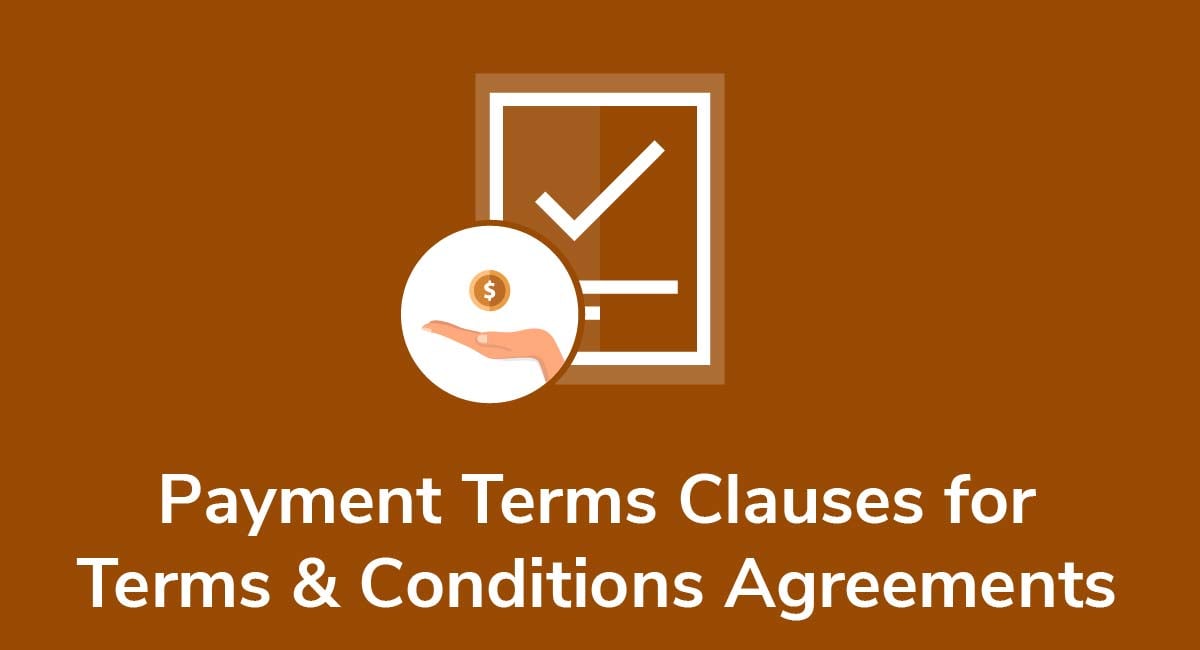How to Decline Refunds
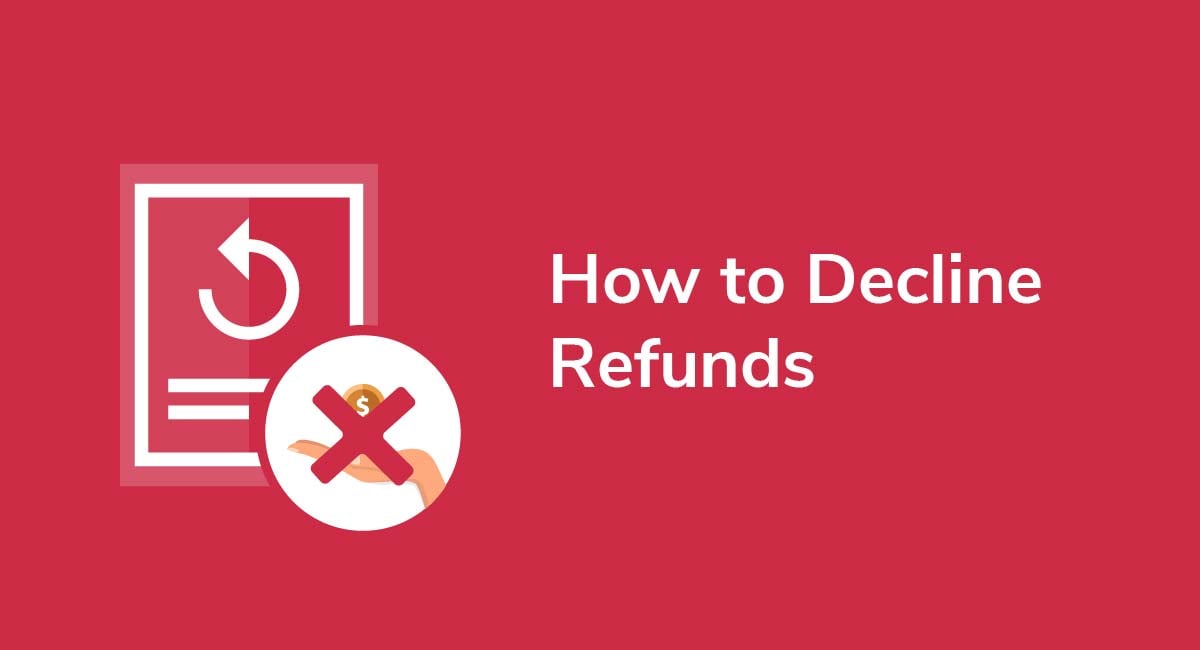
No matter where you are in the world, customers are not always entitled to a refund. Although some countries give consumers more rights than others, you're often able to decline refund requests by law.
Below, we explore when you can typically refuse a refund and how to enforce your company's Return and Refund Policy.
Get compliant today with PrivacyPolicies.com
Select one of our generators to create the required legal agreements for your business:
- Our Privacy Policy Generator can help you generate a customized Privacy Policy in around three minutes, for free.
- Our Terms & Conditions Generator can help you generate a customized Terms & Conditions agreement in around three minutes, for free.
- Our EULA Generator can create a customized End-User License Agreement for your mobile or desktop app.
- Our Cookies Policy Generator can create a customized Cookies Policy to help your compliance with ePrivacy Directive and GDPR.
- Our Disclaimer Generator can create a disclaimer or disclosure for your website.
- Our Return & Refund Policy Generator can help your ecommerce store by creating a returns or refunds policy.
Integrate a free Cookies Notice and Cookie Consent banner to comply with the EU ePrivacy Directive and the new GDPR law regarding cookies.
- 1. Can Customers Demand a Refund?
- 2. When Might a Business Refuse a Refund?
- 3. Can a Business Refuse Refunds?
- 3.1. Legal Position
- 3.2. No Refund Policies
- 3.3. Return and Refund Policies
- 3.4. Goodwill Returns
- 4. Do I Need a Return and Refund Policy?
- 5. Drafting a Return and Refund Policy
- 5.1. What Items are Refundable
- 5.2. Non-Returnable Items
- 5.2.1. When Sales are Final
- 5.3. Timeframe for Making Returns
- 5.4. Exchanges
- 5.5. Gift Vouchers
- 6. Displaying a Return and Refund Policy
- 7. Declining a Customer Refund Request
- 7.1. Be Polite But Clear
- 7.2. Link to Your Store Policies
- 7.3. Consider Goodwill Gestures
- 7.4. Sign Off Courteously
- 8. Summary
Can Customers Demand a Refund?
Customers can always ask for a refund. However, they can't expect one unless one of the following conditions apply:
- Local or national law entitles them to a refund in the scenario
- They are entitled to a refund under your Terms and Conditions agreement or Return and Refund Policy
- You have previously agreed to offer them a refund
So, unless the customer has legal grounds for seeking a refund, they can't demand one.
When Might a Business Refuse a Refund?

There are many occasions when you might refuse to honor a refund request. Businesses often refuse to accept returns on the following items:
- Products which have been damaged by the customer
- Items which are visibly worn or used
- Gift cards, tokens, or vouchers
- Underwear, swimwear, and earrings
- Goods sold through third parties or at special events
- Food or other perishable goods
- Custom orders e.g. a custom cake, t-shirt
- Items which are already heavily discounted such as a final sale or closeout item
- Items sold "as is" e.g. the display furniture at a store
Hunza G, for example, won't accept refunds on gift cards, worn items, or goods sold at special events and the company notes this clear in its Return Policy:
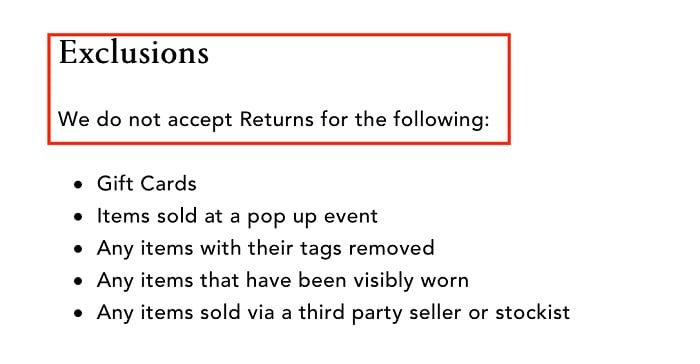
Having clear written terms makes it much simpler to refuse refund requests.
Can a Business Refuse Refunds?

As mentioned, yes, you can often refuse refunds. Here are some ways you can reject refund requests, or how you can offer refunds at your discretion.
Legal Position
Summarizing the various return laws around the world is beyond the scope of this article. However, generally, here are some examples of rules that apply.
There are a variety of return and refund laws in the United States.
Under U.S. federal law, businesses can refuse a refund request unless:
- Different state laws apply which enable customers to seek a refund
- A cooling off period applies
- The product is defective, broken, or damaged, or
- The customer is requesting a refund due to the seller's breach of contract
States also have individual laws quite often. In Connecticut, for example, retailers can refuse a refund request for perishable items and goods clearly marked as non-returnable. Meaning, if you don't display a returns or refund notice somewhere obvious, customers are usually entitled to a refund.
There are also a variety of return and refund laws in the EU. For example, customers have a right to a refund for faulty and misdescribed items.
UK customers have the additional right to return a product if it's not fit for its intended purpose, and in Australia, customers can return items that don't work as advertised.
Make sure you know which laws apply before you decide whether to honor or decline a refund.
No Refund Policies
It's generally legal in some countries, such as the U.S., to have a No Refund Policy unless the customer has rights under federal law.
No Refund Policies are what they sound like: policies informing customers that all sales are final. So long as the terms are clear, you can either include them in your Terms and Conditions Policy or have a separate policy.
Here's an example of a No Refund Policy from YOYA. All sales are clearly final unless the customer can show an item has been damaged in transit:

So long as the terms are clear, and displayed somewhere conspicuous, you can rely on a policy like this in the US. You cannot enforce No Refund notices in EU countries, or countries such as the UK, Australia, or China.
Return and Refund Policies
You can use your Return and Refund Policy to restrict when you'll accept refund requests.
For example, Gymshark normally clearly list items which are non-returnable and for which it won't issue refunds:
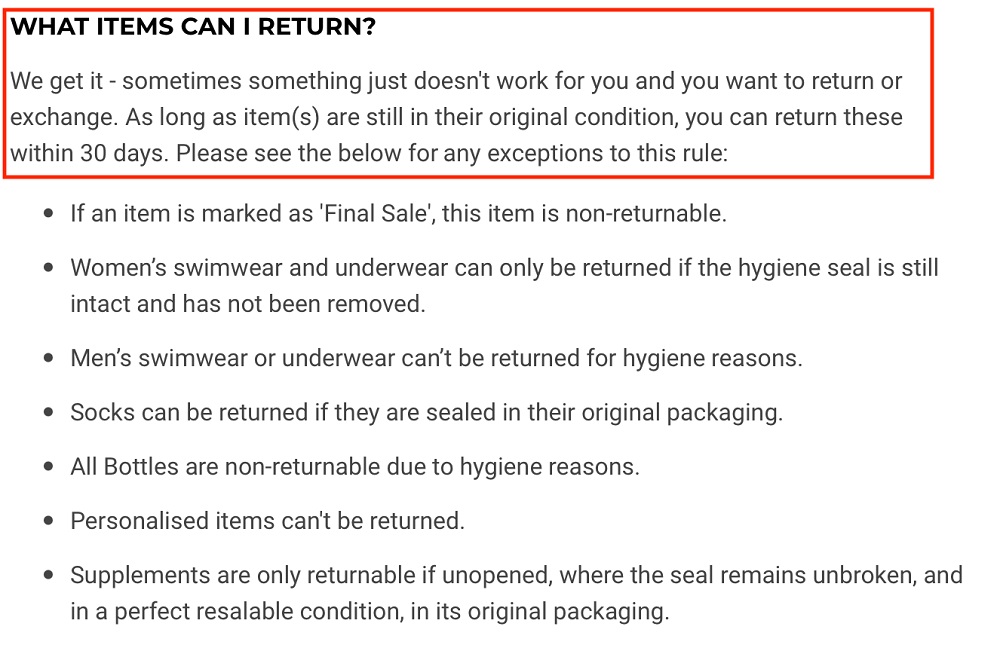
You're within your legal rights to decline a refund request if a customer attempts to return items which breach your terms. Just don't forget to display any policies you have or they likely won't be held enforceable.
Goodwill Returns
Sometimes, a business might want to honor a refund request even if it's not store policy. In other words, they want to show goodwill towards a customer. This is a good way to improve customer satisfaction levels and increase confidence in your business.
For example, if you don't normally accept refund requests made after 30 days, you might make an exception for someone who wants a refund after 35 days. Or, you might accept a refund on a sale item on occasion.
Do I Need a Return and Refund Policy?

If you wish to enforce custom return and refund policies, such as declining refunds, then you likely do need to display your policy clearly so your shoppers know. Otherwise, you will likely have to offer the default refund or return limits set out in local laws.
The easiest and most reliable way to decline refunds is by having a legally enforceable Return and Refund Policy. Here's why:
- A written policy is a contract between you and your customers. If there's a dispute, you can always rely on a well-drafted contract to help resolve matters.
- Written policies help to reduce the likelihood of disputes arising in the first place. Customers can review your terms to understand what they can expect from your store before shopping/creating a contract with you.
- Customer service is important in a competitive market. Well-drafted store policies are a part of quality customer care.
- A store Return and Refund Policy makes your business appear more professional, reliable, and trustworthy.
Drafting a Return and Refund Policy

Every legally enforceable Return and Refund Policy includes certain clauses. The exact clauses you include depend on your business and what if any refunds you want to decline. Here are the main types of clauses you might include in your policy to ensure that you can rely on it if a customer requests a refund.
What Items are Refundable
First, set out when you will process a refund. This helps customers understand what they can (and cannot) return. You don't need to list specific items, but you can be clear about when you'll accept returns.
Macy's will accept most returns (although there are exceptions). For example, the company will accept some cosmetics so long as they're only lightly used:
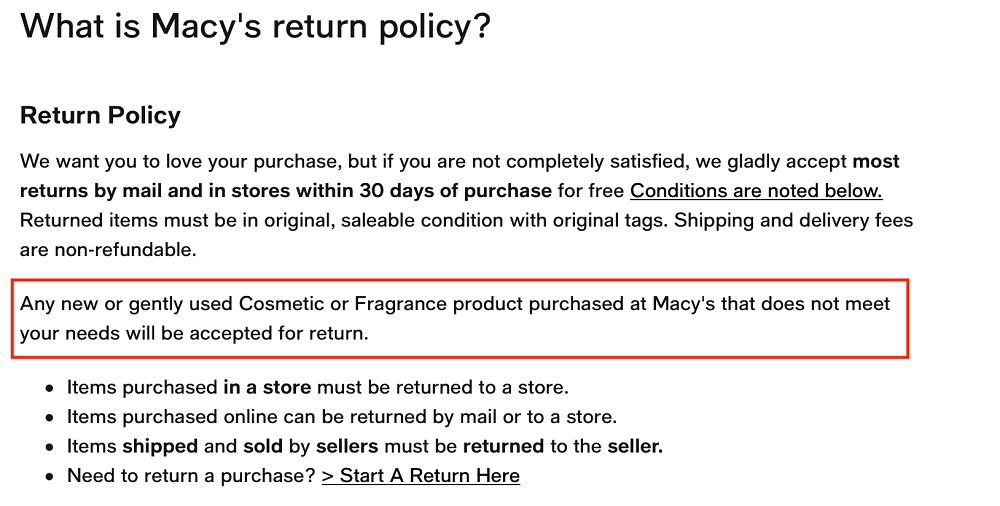
You might also list the returns you'll accept in a "FAQs" format. This is helpful because it avoids using long paragraphs of text and makes it easier for customers to read.
Here's an example of this from Bloomingdale's:

And here's how it approach declining refunds:

You'll note the company uses polite and apologetic but firm language. This is the approach to aim for when you're setting out when you will and won't accept refunds.
Non-Returnable Items
Be specific and clear about what items you do not allow to be returned.
As an example, Ryderwear won't accept returns on visibly worn or used items. It won't accept underwear returns either, unless the items are faulty:

List the non-returnable items clearly so you can easily refer to them when declining a refund request. Specifying a reason why you won't accept the return (e.g. for hygiene reasons) is helpful, too, because you're not just arbitrarily refusing a refund. Giving customers a specific reason means they're less likely to dispute the refusal.
When Sales are Final
It's common for stores to decline refunds on discounted items or products sold "as is" e.g. with a visible or obvious fault. To reject refunds for such items, specify when sales are final in your Return and Refund Policy.
Ryderwear, for example, won't accept returns for outlet items unless they're faulty (which is in line with U.S. federal law):

Helpfully, Ryderwear also has a specific "all sales are final" notice above its outlet items on its website:

Notices like this make it much easier to reject refunds for such items because it's reasonable to assume that a customer knew the terms of sale before they made a purchase.
Timeframe for Making Returns
To decline refunds requested after a certain length of time, ensure there's a clear time limit for making returns in your Return and Refund Policy.
30-day time limits are common. FITJEANS, for example, won't accept returns made 30 days after the order has been received. You'll note that the customer must also notify the company first before returning the item:

Collectif Clothing gives customers 28 days, after which it clearly states it's unable to accept the return:

To reject a refund request out of time, all you need to do is direct the customer to the relevant clause in your Return and Refund Policy.
Exchanges
You might be prepared to offer an exchange on certain items, such as sale items, rather than a refund. If so, then you can specify this condition in your store policy.
For example, you might say something like "discounted items are exchange-only" or "no refunds will be offered for sale items but they may be returned for store credit or an exchange."
Gift Vouchers
Few stores offer refunds on gift vouchers, tokens, or gift cards. That said, you might still want to specify that gift vouchers and similar purchases are non-refundable.
RIXO, for example, makes it clear that gift cards are non-refundable and can't be exchanged for cash:
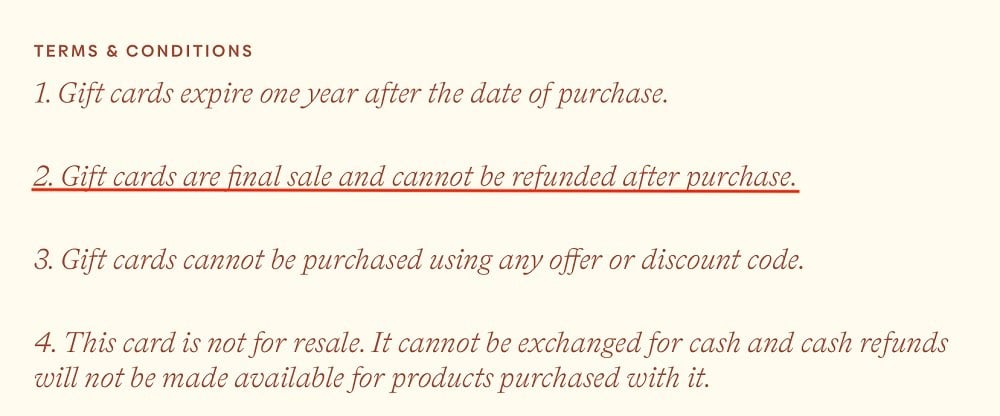
Remember: The point of your Return and Refund Policy is to be as clear as possible as to what your exact rules and requirements are when it comes to accepting returns and issuing refunds (or not doing so).
Displaying a Return and Refund Policy

To be enforceable, your Return and Refund Policy must be easy to locate and very visible. Otherwise, customers can argue that they didn't know your policy existed.
Display your policy somewhere that customers would reasonably expect to find it. For example, Gymshark displays its Returns Policy and related links alongside its other store policies in its website footer:
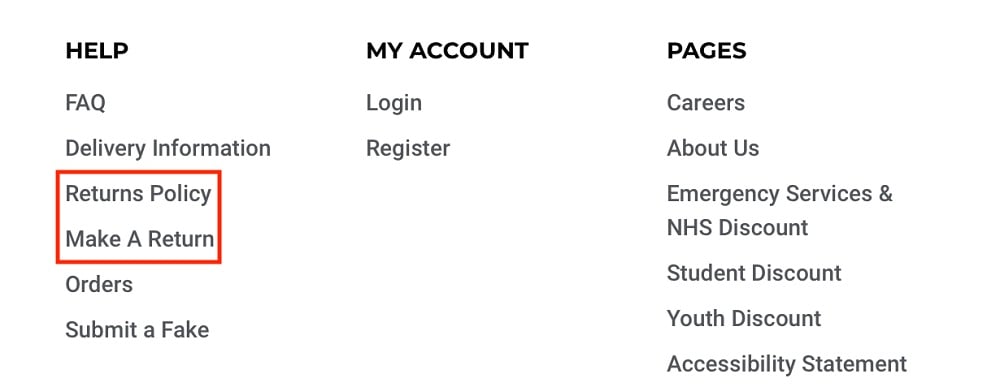
It also link to the Returns Policy within its Terms and Conditions:

Another common place to link to your Return and Refund Policy includes somewhere on the actual checkout screen where a shopper completes a purchase, but this is less common.
Declining a Customer Refund Request

If you wish to decline a refund request, here are some specific steps to take and suggested language to use.
Be Polite But Clear
You need to strike a balance between expressing regret but remaining firm.
- Give a specific reason why you're declining the request. This is less frustrating for the customer and easier to understand.
- You may use apologetic language, such as "unfortunately," "regretfully," or "we are sorry we can't provide a refund on this occasion." However, your position should be clear and firm.
- Show that you've truly considered the request. Use phrases such as, "I've looked into your query," or "after investigating your return request."
- Personalize your response. For example, specify the product they inquired about returning so the customer doesn't think this is a generic email you send to everyone.
Link to Your Store Policies
If you're declining a refund based on store policy, link to the relevant notice in your email response. You should provide a link to your store policy where these terms are made clear.
For example, say you're refusing a refund request because it's outside of your 30-day returns window noted in your policy. You might express regret and explain that you've considered the refund request, but that it's outside of the stated return window.
You can also copy and paste the relevant section into the email for the customer's convenience.
Consider Goodwill Gestures
Just because you can't honor the refund request doesn't mean you're out of options. You may decide to make a goodwill gesture such as:
- Sending the customer a discount code
- Offering money off a particular item or purchase
- Giving them a free trial or a reduction in a membership price
Goodwill gestures can go a long way to making customers feel valued despite their refund request being rejected. And it also goes a long way with keeping people shopping with you, and giving you another chance, versus leaving with a forever bad taste in their mouths about interacting with you.
Sign Off Courteously
You don't want to deter a customer from buying your goods or services in the future. To help keep the lines of communication open, here are some tips for signing off graciously:
- Thank the customer for shopping with you
- Express regret once again
- Remind the customer that they're valued, even if you can't honor their refund request
- Invite the customer to ask questions if they're unclear about anything
Summary
Customers are not automatically entitled to refunds, even in countries like the UK where commercial laws are more generous to consumers.
You can normally decline a refund request unless:
- State or U.S. federal law entitles the customer to a refund, or
- The customer is entitled to a refund under your store policies
Having a Return or Refund Policy makes sense for most businesses selling goods or services. Your policy should, at a minimum, cover the following:
- Timeframe for making returns e.g. 30 day return window
- Conditions for accepting returns
- When sales are final e.g. discounted items, perishable goods
- When exchanges are offered rather than refunds
- If you offer gift vouchers or store credit rather than refunds
Be sure to display your Return and Refund Policy link somewhere obvious, such as within your website header or footer, and within another policy such as your Terms and Conditions agreement.
If you want to decline a refund request, aim to offer a polite, firm, but fair response. Point to the terms of your store policies, consider making a goodwill gesture, and remind the recipient that they're a valued customer.
